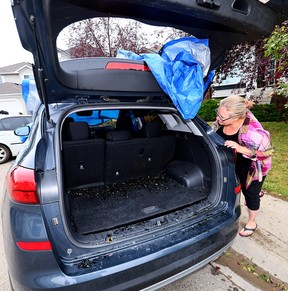The Insurance Bureau of Canada blames the 3.7 per cent rate cap for adding to the challenges facing auto insurers

Article content
The Insurance Bureau of Canada says a severe hailstorm that battered Calgary in August could add to the pressures potentially pushing auto insurers out of the province.
The storm — the second-costliest insurance event in Canada’s history — rained golf ball-sized hail on the city, pummelled rooftops, shattered the windshields of cars and caused flooding at the airport, costing $2.8 billion in losses. Of that amount, $900 million was filed as unexpected claims to auto insurers, according to the IBC.
Advertisement 2
Article content
Aaron Sutherland, vice-president of the Pacific and Western regions of IBC, blames Alberta’s rate cap of 3.7 per cent for what it calls good drivers for adding to the challenges facing auto insurers.
“Under the rate cap, auto insurers are unable to recover from the growing cost of claims over the past two years,” he has said. “This has created a dire economic environment that has forced several companies to leave Alberta’s auto insurance market.”
Sutherland’s statement comes after the departure of two private-sector auto insurers over the summer and a diagnosis of an “auto insurance crisis” in Alberta by credit rating agency Morningstar DBRS, despite Alberta having among the highest auto-insurance premiums in the country.
“Unless the rate cap is removed, the high number of new claims from the hailstorm will contribute to Alberta’s already tenuous market conditions, which may result in more insurance carriers making a similar exit from the market,” Sutherland added.
Recommended from Editorial
-

With claims totalling $2.8B, August hailstorm sets record for insured damages
-

Varcoe: ‘Auto insurance crisis’ prompts insurers to leave Alberta
-

Opinion: Alberta at odds from Western provinces on auto insurance costs, compensation
Article content
Advertisement 3
Article content
The province said it will respond to the industry’s concerns.
“We understand the major cost pressures that insurance companies are facing due to a variety of reasons, and are committed to announcing reforms in the fall that will address those pressures while also ensuring that premiums for Alberta drivers go down,” Finance Minister Nate Horner said in an emailed statement.
Previously, auto insurers weren’t allowed to increase premiums by more than five per cent under the NDP government. The constraint was removed in 2020 by the UCP government, and the profits of insurers rose.
Insurance providers in 2022 collected $6.4 billion in premiums and paid out approximately $4 billion in claims, resulting in an overall collection of $2.4 billion, a more than twofold rise in margin from 2019 of $1.152 billion, and 2018 of $974 million, according to a report by the superintendent of insurance.
However, that isn’t the true picture, Sutherland said.

According to the report, the collections didn’t include expenses incurred by companies. When they were accounted, auto insurers had a profit margin of 3.6 per cent.
Advertisement 4
Article content
The province implemented the 3.7 per cent cap in 2023.
The profitability was hurt by the intervention, stated a report co-written by Nadja Dreff, a senior vice-president at Morningstar DBRS. Despite high profits between 2020 and 2022 after the cap was lifted, insurers suffered a net underwriting loss for the five years ending in 2022.
Insurers say inflation, rise in thefts and higher legal expenses and costs of replacing cars have compelled companies to increase their premiums.
“(A) handful of insurers have left over the past five years,” the report stated. “We believe that others may follow.”
The Insurance Bureau of Canada is calling for an end to the regulation, warning if more insurers leave the Alberta market, “consumers will be forced to find new, typically more expensive coverage elsewhere.”
The problem of high insurance premiums have confounded officials, including the Premier Danielle Smith.
“Look, we’ve had a lot of competition and yet we haven’t had the lowest rates. So something’s wrong with this market,” Smith has said in an earlier interview with Postmedia.
Advertisement 5
Article content
“I’m concerned about the consumer.”
Sutherland said auto insurance premiums in Alberta remain high despite the rate cap because companies in the province offer heftier benefits, in some cases three times that of other provinces such as Manitoba and Saskatchewan. Coverage plans, unlike other provinces, also allow injured parties to sue over damages, lost wages or medical costs.
Alberta also has a higher record of natural calamities that make cars more prone to damages. “Five of the top 10 costliest natural disasters in Canada’s history have all occurred here in Alberta,” Sutherland said.
“Companies don’t leave a marketplace when they’re making money,” he said.
The province has said it is considering sweeping changes and conducted consultation earlier this summer on potential reforms, while releasing two reports studying the sector.
A sticking point has been whether to introduce a no-fault system, as other provinces have done, that determines how injured claimants can seek benefits and care without litigation.
“Do you go to a no-fault system like they have in Saskatchewan, where instead of having the ability to access the courts, you have a schedule of payments that get paid for personal injury?” the premier said.
“Or do we retain the full system of being able to access the courts, and the price of that is higher insurance rates . . . or is there a hybrid?”
— With files from Chris Varcoe
Article content

Based in New York, Stephen Freeman is a Senior Editor at Trending Insurance News. Previously he has worked for Forbes and The Huffington Post. Steven is a graduate of Risk Management at the University of New York.





